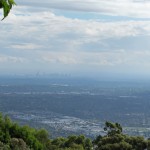
Ah, to get away from the big city for a few days of rest on the weekend or during holidays (of which there are many in Australia)!
You could head to the beach, for there’s plenty of that near Melbourne. First, there is Port Phillip Bay, 260km of coastline in a huge circle – from popular Mornington Peninsula on the east to the Bellarine Peninsula on the west. In either direction, you can reach land’s end at the mouth of the bay in about an hour and a half. The famous Great Ocean Road beckons farther off to the west.
For a different kind of getaway, however, Melburnians head east to the Dandenong Ranges – less than one hour by car, or by an equally quick train ride on the Belgrave line. Most of this beautiful area is up high, a cluster of rolling hills and steep valleys thick with ash trees and tall ferns. The roads wind and twist through the hills, much of which has been turned into National Park, a sinuous contrast to the rectilinear grid of the city. Even with a map, you can easily get lost.
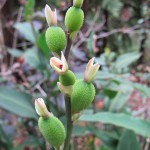
But that is why city dwellers have come here since the 1870s: to get lost in a different world, a break from the tumult of the city. The wealthy, in particular, rode up into these hills to cool off in the summer, or to enjoy their second homes. Many of their gardens and gated estates have now been turned back into parkland for the visiting public to enjoy. Artists and other solitaries who sought a place apart moved here as well. They could even mark their distance from the city – and Port Phillip Bay beyond – across the intervening plains from viewpoints like the 633 meter/2000 foot top of Mt. Dandenong.
As Melbourne grew and spread its suburban fingers toward the Dandenongs, the relative isolation here ended. Now 100,000 people live in the area, while throngs come to visit on the weekends and holidays. The charming little villages along the twisty roads now offer many comfy bed and breakfasts to sleep in. Sassafras aptly features numerous tea salons for high tea. Others like Olinda, Sherbrook, and Kallista offer gardens to visit, art galleries, gourmet restaurants and lower toned ones. And, if these pleasures aren’t your cup of tea, the wineries of the Yarra Valley just north offer other enticements.
In Belgrave, a busier and more commercial town on the train line, you can literally go back in time by riding Puffing Billy, an old steam train that noisily hauls tourists through the woods. Even here, though, on the pleasant side streets, the B&Bs can be charming. We stayed uphill from the main part of town, in a wooded neighborhood visited by possum at night and parrots during the day. In the evening, we sat for hours on the huge porch with the lights of Melbourne shining through gaps in the trees.
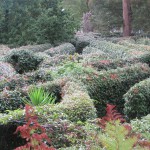
We avoided the crowds in other ways. While local residents bustled about on the roads lower down, and tourists mostly avoided the damp, chilly air, we visited the top of Mt. Dandenong to admire what we could see of the view from the highest vantage point. While there, we found the popular Skyhigh Maze closed, but persuaded the cafe managers to let us try it anyway.
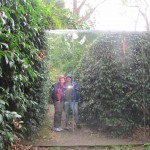
All by ourselves, wrapped in our jackets as cold raindrops fell, we gleefully got lost and found amid the Lilly Pilly box hedges that form the intriguing maze. Statues and totems marked dead ends; resting spots like a fountain and a broad tree amid fallen, orangey leaves marked our successful progress toward the finish.
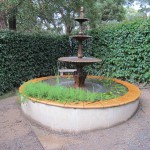
We almost missed out on this. A few hours earlier, after a wrong turn trying to find our way uphill from the busy service center of Upper Ferntree Gully, we were hailed by a burly, bearded SUV driver and pulled over. “Did you know you had a flat tire, mate?” he called out. After our futile attempts to get quick help from the rental car company, the driver hauled out his equipment and started changing the tire. We weren’t allowed to do a thing. “Well, now you know the kind of friendliness you can find here in Oz,” he said as we thanked them for their extraordinary courtesy. Sometimes it’s good not to be alone.
That was on Thursday. The next day began the four day long Easter holiday and seemingly every Melburnian showed up in the Dandenongs. By early morning, cars thronged the main park area at Upper Ferntree Gully and spilled onto the nearby roads. The visitors overran the park’s various walks and myriad picnic spots. Up higher in Sassafras, we couldn’t even get a warming tea, as crowds thronged the tearooms waiting to get in.
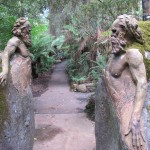
So, we thought we would head instead to the haunts of those solitaries who came here to get away from it all. First was the Ricketts Sanctuary, a rambling estate where the sculptor and recluse William Ricketts practiced his life’s passion. Ricketts was a lover of nature, the wild beauty of the Dandenongs, and aboriginal tribespeople – all betrayed and threatened, as he saw it, by his white compatriots.

Here, in his retreat, he aimed to capture in clay the mythic grandeur he saw in those tribes, plus express the animist philosophy and religion he shared with them. The result was 92 statues, friezes and reliefs he spent the latter half of his life creating. He distributed these around the winding contours of his four acre property, precisely fitting each piece into natural niches there. Mostly figurative and realistic, the works show great energy and sweeping movement, almost as if William Blake’s drawings were re-cast in clay.
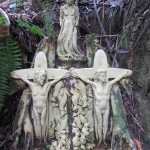
The overall impact is impressive, even if at times Ricketts proves a bit too grandiose, as when he uses his own figure as Christ, or fawning as in the many gleaming faces of aboriginal children. Still, most of the pieces are vivid and memorable, full of commitment and passion for his subject, as in his depiction of a scowling, muscular devilish figure of war and nature’s depradation, as well as his self-assuredness in his beliefs.
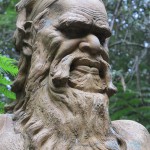
They demand you reflect on their meaning, from the larger symbol-laden works to the minuscule details and placements. Though we didn’t have to contend with throngs of Easter holidaymakers, enough of them were here with us to make the sanctuary somewhat less serene and contemplative. And we wondered what the solitary Ricketts would think about all these people amid his beloved hills.
As we left the sanctuary, the park warden helpfully suggested we go where “few people would be heading” today: the Alfred Nicholas Gardens. There Nicholas – who made it rich from the Aspro painkiller he developed with his brother – had created a 25 hectare (63 acre) estate in the 30s, now managed by the state of Victoria. We thought the warde might be right since we had some trouble finding the place, until we found the parking lot completely full. We had to wait until someone left before we could deposit the car. So many seemed to know about it: even the UK site of TripAdvisor, we later found, has 320 reviews of the place.
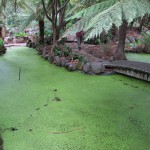
As it turned out, happily, only a few spots in the huge estate were actually bustling. We could easily walk around the edges of the property – along the sunken pathway, down through the bush walk and within the fascinating arboretum – and get away from everyone.
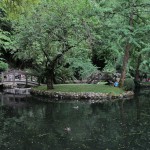
As a result, the place was appealingly peaceful. Even the main gathering spots were enjoyable: the upper pools like a Japanese garden where tiny leaves carpeted the surface of the water, and the lower lake with several islands and bridges where small groups quietly picnicked (including a Socratic older man on a cooler lecturing to two rapt couples).

People also gathered at the chain-link fencing around Burnham Beeches, the grand Art Deco home Nicholas had built for himself. Decorated with moderne zig-zag patterns, as well as stylized koalas, the building had been turned into a hotel in the 80s, then abandoned. Plans now involve making the whole place an eco-resort…a magnet, the developers hope, for yet more crowds.
Maybe the crowds don’t much matter to the solitary soul, the artist, or a quirky individual, all of whom find a way do their own thing. Take, for example, the owner of Brother Jon’s Café in Sassafras.
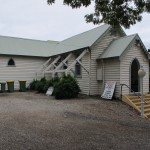
We had tried this place when all the tea rooms in Sassafras were overwhelmed. The sign outside had advertised the most delicious scones, and the café was after all an actual church on the hill into town…so we believed. The interior still appeared to be a church, already set for a wedding dinner, with the café seating at the trellised-back end.
It turned out that the scones were quite good, though expensive, and the service exactly what Urban Spoon reviewers have described as a hilarious scene from Fawlty Towers. Long waits, the scones arriving way before the tea, the need to plead for our tea while the two waiters fumbled to sort out a couple’s bill, plain tea bags rather than a real tea service…and a waiter so old that we wanted to take care of him, not the other way around.
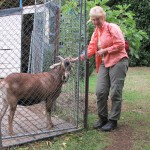
When all was done, the elderly waiter apologized for things. And he made up for it by inviting us to see the gardens…amazing. Hidden behind the church we found a sizable, cultivated English garden full of lemon trees and flowering plants. Alongside the garden sat a stately, elegant, but modest sized mansion, and up a short hill to its left bleated Ceecee the goat, who loved to be scratched between the ears. Visiting that elegant setting was worth all the proper tea we might have had.
And then, as we tried to leave, we met the owner – a short, wiry woman who let us know she was 85. She had come to this area back in 1970 and decided to buy a decommissioned church and the garden space behind, converting the church into a café and wedding site. Turning over the pages of a picture album, she pointed out images of the grounds as they were, years of wedding celebrations and the restoration of the church itself. She talked about trips to the U.S. and travelers she had met from there. She boasted of visits from her friendly kookaburras, large Aussie kingfishers, that the photos showed gathered on her mansion fence. She showed pictures of the parrots that regularly whooshed into her house, helping themselves to some treats. She talked of dear Ceecee whose eyes were different colors and whom she rescued from the goat slaughterhouse as a kid.
But now it was time to retire, she added. The church and its land were for sale, but not the back parcels where her small mansion and gardens sat. She might not want to make scones for the public any more, but she still liked her grand hideaway in the Dandenongs. Like the parrots, the tourists might whoosh in and whoosh out for a treat, but she wasn’t going anywhere.
(Also, for more pictures from Australia, CLICK HERE to view the slideshow at the end of the Australia itinerary page.)


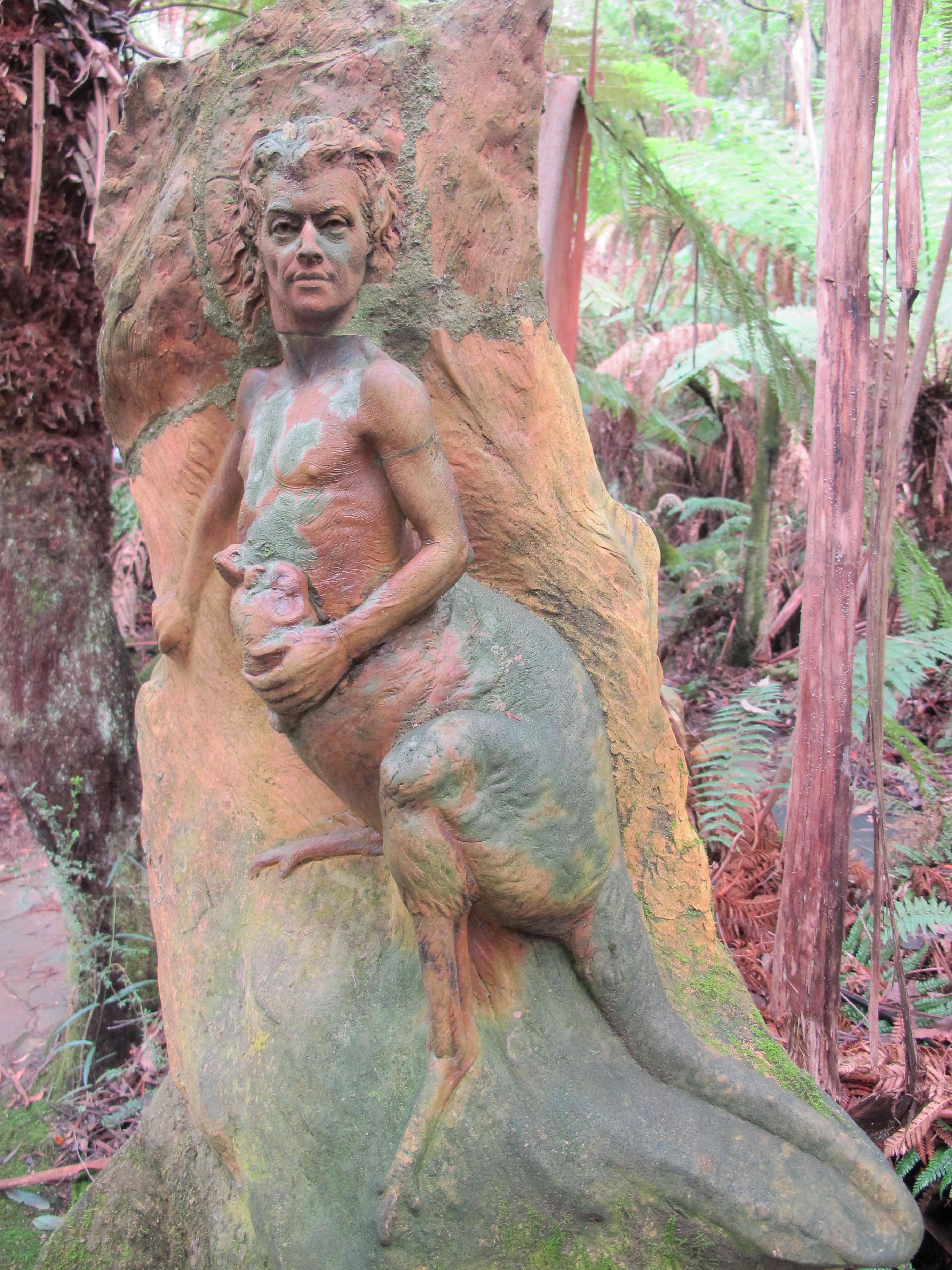
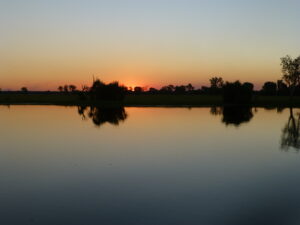
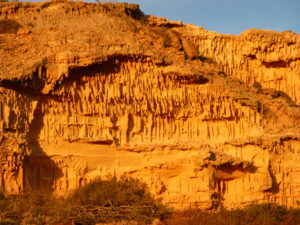

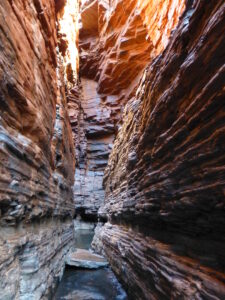
Greats comments and site.